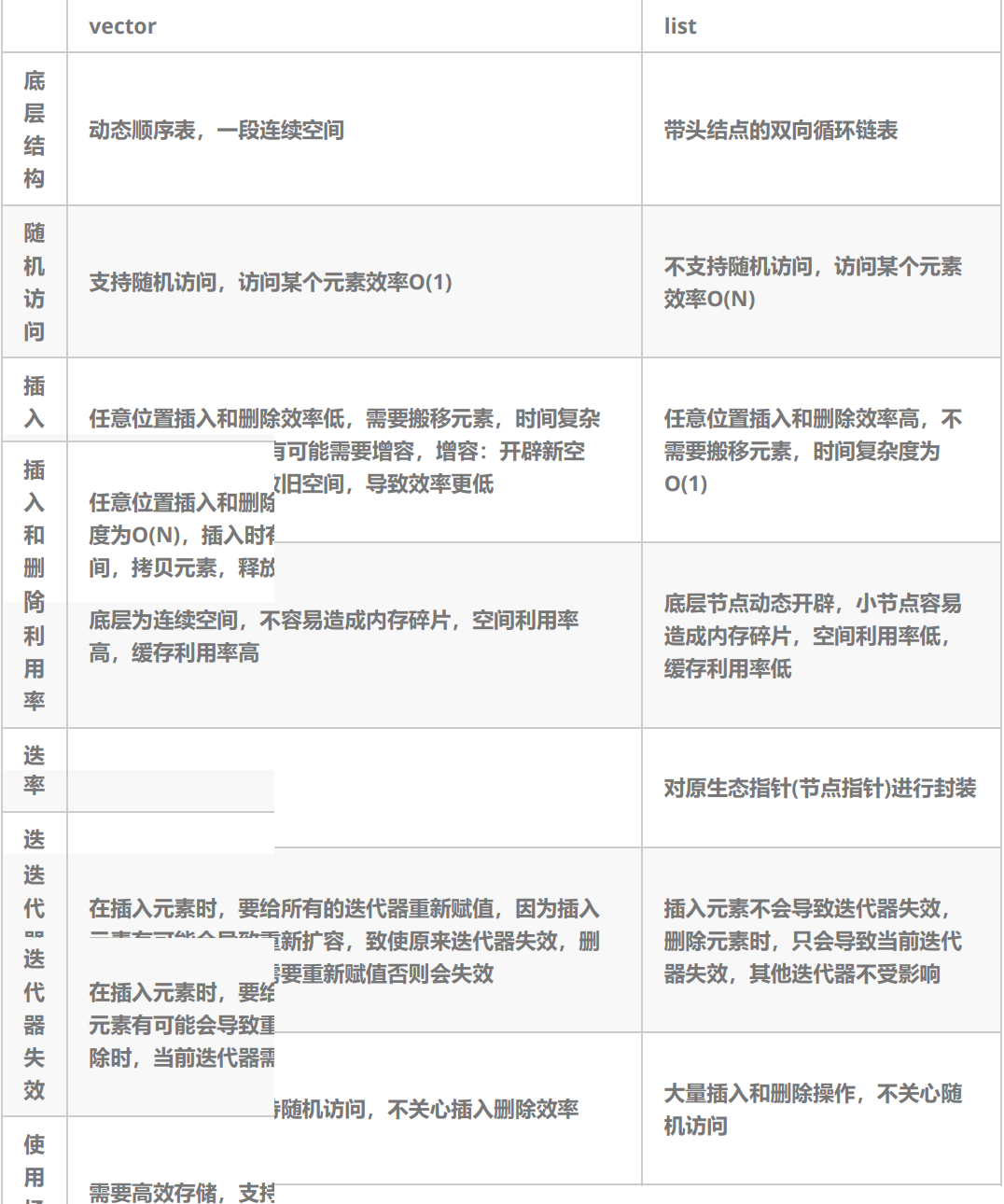一、list类的实现(放在my_list命名空间域中)
将整体的实现放在list.h头文件中
cpp
#pragma once
#include<iostream>
#include<assert.h>
using namespace std;
namespace my_list
{
//struct定义节点
template<class T>
struct list_node
{
list_node* _next;
list_node* _prev;
T _val;
//构造函数
list_node(const T& val = T())
:_next(nullptr)
,_prev(nullptr)
,_val(val)
{ }
};
//迭代器封装(这里把迭代器封装成了类,然后进行使用迭代器的++等操作)
template<class T, class Ref, class ptr>
struct list_iterator
{
typedef list_node<T> node;
typedef list_iterator<T, Ref, ptr> self;
node* _node;
//构造函数(单参数支持隐式类型转换)
list_iterator(node* node)
:_node(node)
{
}
//解引用运算符重载
Ref operator*()
{
return _node->_val;
}
//->重载
ptr operator->()
{
return &_node->_val;
}
//后置++运算符重载
self& operator++()
{
_node = _node->_next;
return *this;
}
//前置++运算符重载
self operator++(int)
{
self tmp(*this);//拷贝构造一份
_node = _node->_next;
return tmp;
}
//后置--运算符重载
self& operator--()
{
_node = _node->_prev;
return *this;
}
//前置--运算符重载
self operator--(int)
{
self tmp(*this);//拷贝构造一份
_node = _node->_prev;
return tmp;
}
//!=运算符重载
bool operator!=(const self& it)const
{
return _node != it._node;
}
};
template<class T>
class list
{
typedef list_node<T> node;//内部使用,,不用公有,私有就行
public:
typedef list_iterator<T, T&, T*> iterator;//外面要使用这个迭代器,所以要让它公有
typedef list_iterator<T, const T&, const T*> const_iterator;
//const迭代器如何设计呢?
//typedef const_list_iterator<T> const_iterator;
//不能像上面这样设计const迭代器,因为const迭代器是指向的内容不能修改,而不是本身不能修改
//在operator*运算符重载处返回的T上加const九不能修改了
//构造函数
list()
{
_head = new node;
_head->_next = _head;
_head->_prev = _head;
}
//析构函数
~list()
{
clear();
delete _head;
_head = nullptr;
}
//cear函数
void clear()
{
iterator it = begin();
while (it != end())
{
it = erase(it);
}
}
//拷贝构造
list(const list<T>& lt)
{
_head = new node;
_head->_next = _head;
_head->_prev = _head;
for (auto& element : lt)
{
push_back(element);
}
}
//迭代器
iterator begin()
{
return _head->_next;//单参数的构造函数支持隐式类型转换
}
iterator end()
{
return _head;
}
//const迭代器
const_iterator begin()const
{
return const_iterator( _head->_next);//单参数的构造函数支持隐式类型转换
}
const_iterator end()const
{
return _head;
}
//push_back函数(也可以使用insert直接进行哨兵位的前面插入就是尾插)
void push_back(const T& x)
{
//保存尾节点
node* tail = _head->_prev;
//开新节点
node* newnode = new node(x);
tail->_next = newnode;
newnode->_prev = tail;
newnode->_next = _head;
_head->_prev = newnode;
}
//insert函数(在pos位置之前插入)
iterator insert(iterator pos, const T& x)
{
node* current = pos._node;
node* prev = pos._node->_prev;
node* newnode = new node(x);
prev->_next = newnode;
newnode->_prev = prev;
newnode->_next = current;
current->_prev = newnode;
return newnode;
}
//erase函数
iterator erase(iterator pos)
{
assert(pos != end());
node* prev = pos._node->_prev;
node* next = pos._node->_next;
prev->_next = next;
next->_prev = prev;
delete pos._node;
pos._node = nullptr;
return next;
}
//pop_back尾删函数
void pop_back()
{
erase(--end());
}
//push_front头插函数
void push_front(const T& x)
{
insert(begin(), x);
}
//pop_front头删函数
void pop_front()
{
erase(begin());
}
//size函数
size_t size()
{
size_t sz = 0;
iterator it = begin();
while (it != end())
{
++it;
++sz;
}
return sz;
}
//赋值重载
void swap(list<T>& lt)
{
std::swap(_head, lt->_head);
}
list<T>& operator=(list<T> lt1)
{
swap(lt1);
return *this;
}
private:
node* _head;
};
}注意:const迭代器和普通迭代器使用两个模板参数就可以完成
二、对模拟实现的list进行测试
cpp
#include "list.h"
//const迭代器测试
void print(const my_list::list<int> lt)
{
my_list::list<int>::const_iterator it = lt.begin();
while (it != lt.end())
{
cout << *it << endl;
++it;
}
}
void test_my_list1()
{
//尾插数据
my_list::list<int> lt1;
lt1.push_back(10);
lt1.push_back(8);
lt1.push_back(35);
lt1.push_back(23);
lt1.push_back(4346);
//迭代器遍历
my_list::list<int>::iterator it = lt1.begin();
while (it != lt1.end())
{
cout << *it << " ";
++it;
}
cout << endl;
//范围for
for (auto element : lt1)
{
cout << element << " ";
}
cout << endl;
print(lt1);
}
struct A
{
public:
A(int a = 0, int b = 0)
:_a(a)
,_b(b)
{ }
int _a;
int _b;
};
void test_my_list2()
{
//尾插数据
my_list::list<A> lt1;
lt1.push_back(A(1,1));
lt1.push_back(A(2,2));
lt1.push_back(A(3,3));
//测试->重载
my_list::list<A>::iterator it = lt1.begin();
while (it != lt1.end())
{
cout << (*it)._a << (*it)._b << endl;
cout << it->_a << it->_b << endl;
//这里按照语法严格来说是it->->_a,但是由于运算符重载要求可读性,编译器做了特殊处理,省略了一个->
++it;
}
cout << endl;
}
void test_my_list3()
{
//尾插数据
my_list::list<int> lt1;
lt1.push_back(10);
lt1.push_back(8);
lt1.push_back(35);
lt1.push_back(23);
lt1.push_back(4346);
//头插数据
lt1.push_front(1);
lt1.push_front(2);
lt1.push_front(3);
lt1.push_front(4);
//打印
for (auto element : lt1)
{
cout << element << " ";
}
cout << endl;
//头删一个,尾删两个
lt1.pop_front();
lt1.pop_back();
lt1.pop_back();
//打印
for (auto element : lt1)
{
cout << element << " ";
}
cout << endl;
//清除重新插入数据
lt1.clear();
lt1.push_front(1);
lt1.push_front(2);
lt1.push_front(3);
lt1.push_front(4);
//打印
for (auto element : lt1)
{
cout << element << " ";
}
cout << endl;
}
void test_my_list4()
{
//拷贝构造测试
my_list::list<int> lt1;
lt1.push_back(1);
lt1.push_back(2);
lt1.push_back(3);
lt1.push_back(4);
lt1.push_back(5);
my_list::list<int> lt2(lt1);
//打印lt2
for (auto element : lt2)
{
cout << element << " ";
}
cout << endl;
//赋值重载测试
my_list::list<int> lt3 = lt1;
for (auto element : lt3)
{
cout << element << " ";
}
cout << endl;
}
int main()
{
test_my_list1();
test_my_list2();
test_my_list3();
test_my_list4();
return 0;
}三、vector和list对比
